A well-designed kitchen layout can differentiate between smooth operations and frustrating bottlenecks, especially in a busy hospitality setting.
How a kitchen is arranged directly impacts workflow efficiency, making it crucial to plan a layout that improves functionality while minimizing unnecessary movement.
Whether cooking for a family or managing a commercial kitchen, the proper layout can save time, reduce stress, and improve safety.
When planning your kitchen layout, consider factors like the shape of your space, the flow of movement, and the placement of crucial appliances. Additionally, it’s critical to ensure that your kitchen adheres to safety regulations for both home and commercial environments.
In this article, we’ll explore various kitchen layout ideas, discuss the importance of choosing the right kitchen shape, and provide practical tips for implementing a new design that works for your space.
What is a Kitchen Layout?
A kitchen layout refers to the arrangement of appliances, countertops, storage areas, and work zones within a kitchen space.
It dictates how you move around the kitchen, influencing everything from cooking efficiency to cleaning. In a commercial kitchen, whether in a restaurant or the catering industry, the layout ensures operations run smoothly and safely.
An efficient kitchen layout is decisive for hotel and restaurant operations, where timing and precision are essential. A well-planned layout can significantly improve workflow, allowing chefs and kitchen staff to work without unnecessary delays.
It also increases safety by minimizing the risk of accidents, such as slips and falls, by ensuring that high-traffic areas are clear. Additionally, a thoughtful layout boosts productivity, enabling staff to complete tasks quickly and effectively, which is vital in fast-paced environments.
7 Factors Influencing Kitchen Layout
Designing the perfect kitchen is akin to crafting a signature dish—it requires a blend of artistry, practicality, and a dash of personal flavor.
To achieve this, one must take into account several factors that influence the kitchen layout. These elements serve as the building blocks for creating a space that looks stunning and functions flawlessly.
1. Available Space
The dimensions of your kitchen serve as the canvas for your culinary masterpiece. Whether you’re working with a compact kitchenette or a spacious gourmet kitchen, understanding your space constraints is crucial. It dictates how you can arrange cabinets, appliances, and workstations to optimize every square inch.
2. Cooking Habits
Your culinary inclinations play a pivotal role in kitchen layout decisions. Frequent bakers may prioritize counter space for kneading dough, while passionate chefs might opt for a larger stovetop and ample prep areas. Consider how you like to cook and tailor your layout to match your techniques and habits.
3. Design Preferences
The aesthetics of your kitchen should resonate with your personal style. Do you lean towards a modern, minimalist look or a cozy, rustic charm? Your choice of materials, colors, and finishes should reflect your design sensibilities. After all, the kitchen is not just a workspace; it’s an extension of your personality.
4. Workflow and Ergonomics
Efficiency is the heartbeat of any kitchen. A well-planned layout streamlines your cooking process. It minimizes unnecessary steps and ensures that ingredients, utensils, and appliances are within arm’s reach. Consider the classic kitchen work triangle—connecting the sink, stove, and refrigerator—as a guide to optimal workflow.
5. Family Dynamics
If your kitchen doubles as a gathering space for family and friends, take into account the dynamics of these interactions. Open layouts that flow into living or dining areas promote togetherness, while designated kitchen islands can serve as social hubs.
6. Storage Needs
Assess your storage requirements, from pots and pans to pantry items. Adequate cabinetry, shelves, and drawers are essential to keep your kitchen organized and clutter-free. Customized storage solutions can make a world of difference.
7. Budget Constraints
Real-world considerations come into play as well. Your budget will influence the materials you choose, the appliances you can afford, and whether you can embark on a full-scale renovation or opt for smaller updates.
Customization is the key to crafting a kitchen layout that aligns with your unique needs and desires. It’s not just about following trends but creating a space that celebrates your culinary journey and your lifestyle.
16 Innovative Kitchen Layout Ideas
Choosing the right kitchen layout is essential for creating a functional and aesthetically pleasing space. Different layouts cater to various needs, whether for a cozy home kitchen or a bustling restaurant.
Below are 16 innovative kitchen layout ideas to help you design the perfect kitchen for your space.
1. Galley Kitchen Design

The galley kitchen layout, often called a corridor kitchen, is famous for small spaces. This design features two parallel countertops with a walkway in between, creating a compact and efficient workspace.
The galley layout is ideal for maximizing limited space. It allows for a streamlined workflow, with everything within arm’s reach.
The galley kitchen is often the go-to choice in small apartments or older homes because it optimizes space without compromising functionality. This layout is standard in commercial kitchens, particularly in environments with premium space, but efficiency must be maintained.
Its linear design helps minimize the distance staff need to travel between different workstations, which is crucial in fast-paced settings like restaurants and cafes.
2. L-Shaped Kitchen Layout
The L-shaped kitchen layout is versatile and fits well into corner spaces. This design features countertops on two adjacent walls, forming an “L” shape.
The L-shaped layout is ideal for homes and kitchens that need to accommodate multiple cooks. It offers ample space for movement while keeping everything accessible.
The L-shaped layout can be adapted to larger kitchens by extending one or both arms of the “L” to create additional workspace.
This design is especially beneficial in environments where different stations must be separated, such as in bakeries where mixing and baking areas are kept distinct.
The L-shaped layout can also be combined with an island to enhance its functionality further, providing even more prep space and storage options.
3. U-Shaped Kitchen
The U-shaped kitchen layout maximizes both home and commercial kitchen counter space, making it a popular choice for home kitchens and commercial kitchen layouts.
This design features countertops on three walls, forming a “U” shape that surrounds the cook with everything they need. The U-shaped layout is particularly effective in larger kitchens with plenty of room to work.
In the kitchen design idea world, the U-shaped layout is often used in restaurants that require multiple workstations within a confined area. This design allows chefs to have dedicated space while keeping everything they need nearby.
The U-shaped layout is also ideal for restaurants with open kitchen designs. It creates a visually appealing and efficient workspace that allows chefs to interact with customers while they cook.
4. Island Kitchen Layout
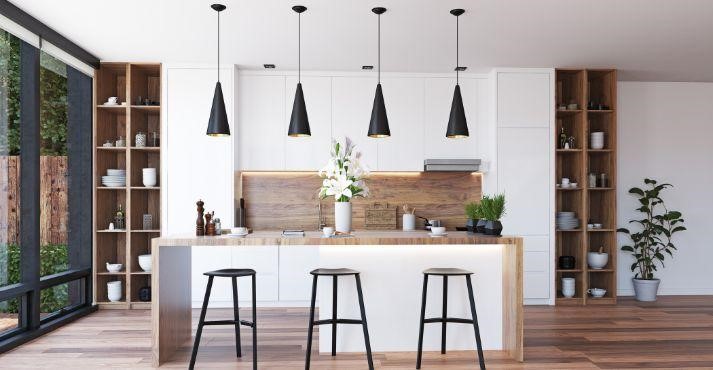
The island kitchen layout is one of the most versatile ideas, offering additional prep space, storage, and seating options.
An island can be incorporated into almost any kitchen shape idea, from L-shaped to U-shaped layouts, adding a focal point that boosts the space’s functionality and aesthetics.
In high-end hotel kitchens, the island layout is often used to create a central workspace where chefs can prepare dishes in full view of the diners. This layout is also popular in modern kitchen layouts where open-concept designs are favored.
The island serves as a gathering point for social interaction, making it ideal for home kitchens and commercial spaces that want to blend cooking and dining areas.
5. Peninsula Kitchen Layout
The peninsula kitchen layout is an excellent option for smaller spaces that need to maximize efficiency without sacrificing functionality. A peninsula is a connected island, where one end is attached to a wall or counter, creating an extended work surface that juts out into the kitchen.
This layout is particularly effective in kitchens with limited space, but additional counter or seating space is desired.
The peninsula layout can significantly improve workflow efficiency by providing a dedicated meal prep, cooking, or casual dining area.
It creates a natural boundary that helps separate the kitchen from other living areas without walls, making it an excellent choice for open-concept spaces.
6. Open Kitchen Layout
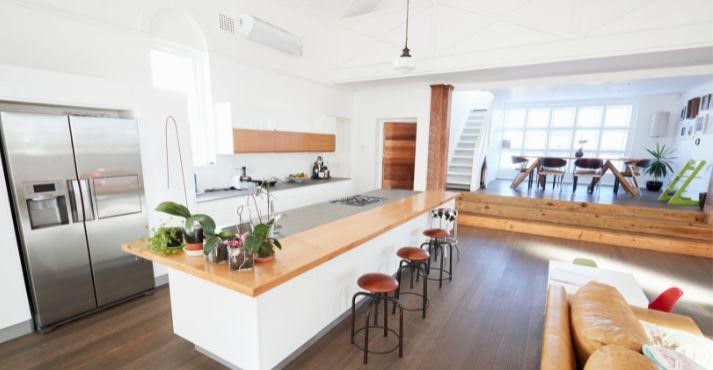
The open kitchen layout is increasingly popular in modern kitchen layouts, particularly in restaurants emphasizing transparency and customer engagement.
In an open kitchen, there are minimal barriers between the kitchen and dining area, allowing customers to see the cooking process. This design augments the dining experience and promotes a sense of trust and openness between the chef and the patrons.
In addition to its aesthetic appeal, the open kitchen layout fosters a collaborative atmosphere among kitchen staff, eliminating walls that can hinder communication. This layout is also ideal for full-service hotels, where the dining experience is critical to the guest’s overall stay.
Hotels can showcase their culinary expertise and create a more interactive dining environment by allowing guests to observe the preparation of their meals.
7. Zone Kitchen Layout
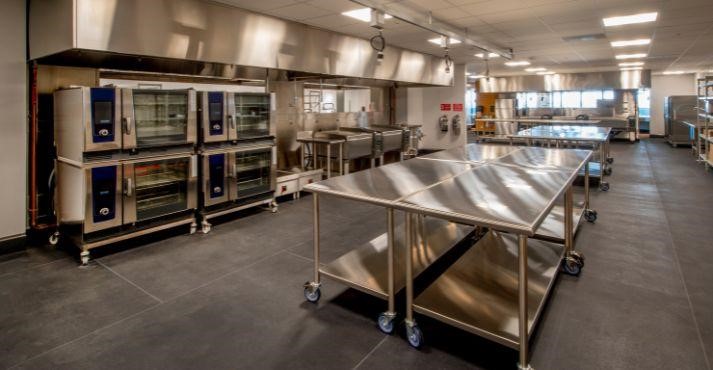
The zone kitchen layout is a highly efficient kitchen design idea that divides the kitchen into specific work areas, each dedicated to a particular task, such as cooking, prep, baking, or cleaning.
This layout is especially beneficial in large-scale operations, where multiple chefs and kitchen staff must work simultaneously without getting in each other’s way.
In a zone layout, each kitchen section is equipped with the tools and appliances necessary for the tasks assigned to that area. For example, the cooking zone would include the stove, oven, and other kitchen utensils, while the prep zone might have cutting boards, knives, and prep sinks.
This organization helps modernize workflow and ensures that each area operates independently yet efficiently. This layout is particularly advantageous in commercial settings where productivity and efficiency are paramount.
8. Circular Kitchen Design
The circular kitchen layout is a unique and innovative approach that centralizes all kitchen activities around a central point, often called the “hub.”
This design is particularly effective in creating an efficient workflow. It minimizes the distance between different workstations, allowing for quick and easy movement around the kitchen.
The circular layout in modern kitchen layouts, particularly in high-end restaurants and innovative hotel designs, creates a visually striking and highly functional workspace.
This layout is especially beneficial in open kitchen designs, where the central hub becomes a focal point for staff and customers.
The circular design enhances efficiency and promotes a sense of unity among kitchen staff, as it encourages collaboration and communication in a shared space.
Additionally, incorporating the latest food service technology into the central hub can optimize operations, making the circular kitchen layout a cutting-edge choice for contemporary kitchens.
9. Commercial Kitchen Layout
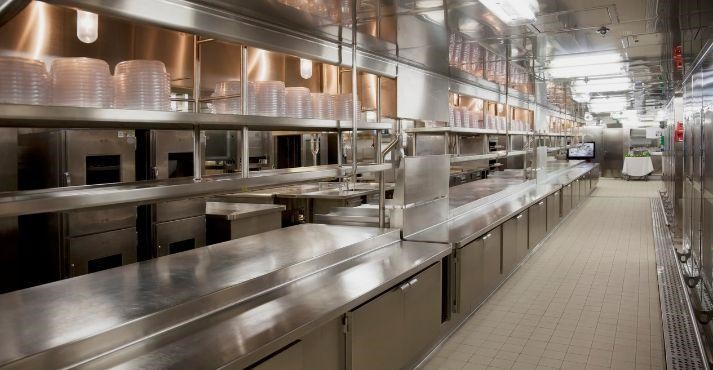
Efficiency, safety, and functionality are paramount when designing a commercial kitchen layout. Unlike residential kitchens, commercial kitchens are designed to handle high volumes of food preparation, with multiple staff members working simultaneously.
A well-planned commercial kitchen layout ensures that all processes—from cooking to cleaning—run smoothly, minimizing downtime and enhancing productivity.
Effective commercial kitchen designs often feature specific zones for different tasks, such as food preparation, cooking, and dishwashing, to avoid cross-contamination and rationalize workflow.
One common example is the assembly line layout, where stations are arranged linearly to facilitate a sequential flow of tasks, from raw ingredient preparation to final plating.
Another popular design is the open kitchen, where chefs can prepare meals for customers, adding an element of transparency and interaction.
10. Modular Kitchen Layout
The modular kitchen layout is known for its flexibility and customization, making it an ideal choice for those who want a kitchen that can adapt to changing needs.
This layout consists of pre-made modules or units, such as cabinets, countertops, and appliances, which can be assembled and rearranged to fit the specific dimensions and requirements of the kitchen space.
One key benefit of the modular layout is its ability to be easily modified. Whether you’re expanding your kitchen or updating its look, the modular design allows for quick and cost-effective changes without needing a complete overhaul.
This adaptability makes it particularly suitable for kitchens in rental properties, where long-term installations may not be feasible. The modular kitchen layout is also trendy in modern kitchen layouts, where sleek, updated designs are preferred.
11. Parallel Kitchen Design
The parallel kitchen layout is characterized by two parallel workspaces with a walkway in between.
This layout is particularly efficient for high-traffic areas, as it allows multiple people to work simultaneously without getting in each other’s way. The parallel design is often used in busy restaurants where speed and efficiency are crucial.
In a parallel kitchen, one side is typically used for cooking, with stoves, ovens, and fryers, while the other is reserved for preparation and storage. This separation of tasks helps rationalize the cooking process and reduces the risk of cross-contamination.
The parallel layout is also space-efficient, making it ideal for narrow kitchens where maximizing available space is a priority.
12. Single Wall Kitchen Layout
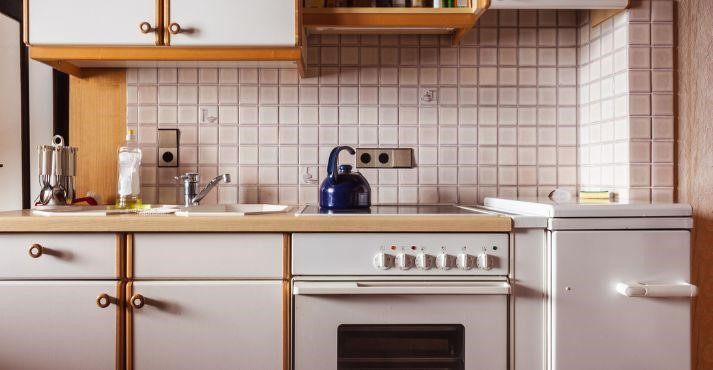
The single-wall kitchen layout is minimalist; all kitchen appliances, countertops, and storage units are aligned along a single wall.
This layout is ideal for compact spaces like small apartments, studio flats, or even small cafes and bars. Despite its simplicity, the single-wall layout can be highly functional if designed thoughtfully.
In a small café or bar, the single-wall kitchen layout allows for an efficient workspace where everything is within easy reach. Storage solutions such as overhead cabinets and under-counter storage can be utilized to maximize efficiency.
Additionally, this layout can be paired with a small island or a foldable dining table to create a multipurpose space that serves both cooking and dining needs. The single-wall layout’s simplicity and space-saving design make it a practical choice for kitchens where space is at a premium.
13. Double Island Kitchen Design
The double island kitchen layout epitomizes luxury and functionality, offering maximum prep and storage space. This layout features two separate islands, providing ample room for cooking, preparation, and even casual dining.
The double island design is particularly popular in large, open-concept kitchens where space is not a constraint. It allows for a more expansive and versatile workspace.
In luxury hotel kitchens, the double island layout is often used to separate different culinary tasks. For example, one island may be dedicated to food preparation and cooking, while the other serves as a plating and serving station.
This separation helps simplify the cooking process, ensuring that each task is carried out efficiently without overlapping.
Additionally, the islands’ extra storage space helps keep the kitchen organized and clutter-free, making it easier for chefs to focus on their work. This modern kitchen layout is a hallmark of sophisticated kitchen design, combining practicality with high-end aesthetics.
14. G-shaped Kitchen Layout
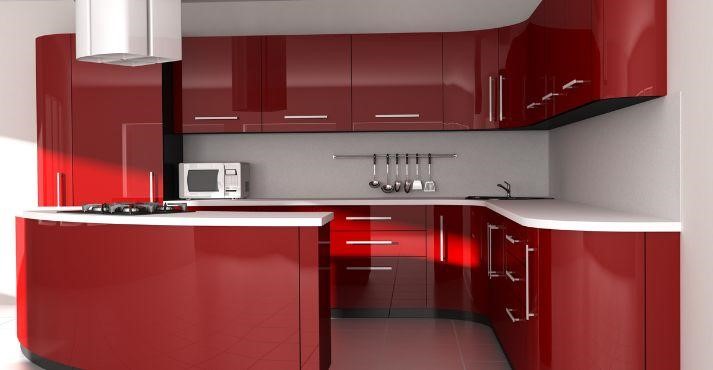
The G-shaped kitchen layout extends the U-shaped design with an additional peninsula that forms a “G” shape. This layout is particularly beneficial for creating extra counter space, making it ideal for high-volume kitchens that require multiple workstations.
The G-shaped layout provides a continuous flow of countertops and cabinets, allowing for efficient movement and easy access to all kitchen areas.
The G-shaped layout offers an increased surface area for food preparation and storage in high-volume kitchens, such as restaurants or catering operations. This layout can accommodate multiple cooks simultaneously, each working in their designated space without interference.
The G-shaped design also allows additional seating or a breakfast bar, making it a versatile option for residential and commercial kitchen layouts. The extra counter space and storage make the G-shaped layout a practical choice for kitchens that need to handle many tasks efficiently.
15. Flow Kitchen Layout
The flow kitchen layout is designed with a focus on smooth movement and efficiency, ensuring that each task in the kitchen follows a logical progression.
This layout emphasizes the natural flow of work, from food preparation to cooking and cleaning, minimizing backtracking and unnecessary steps. The flow layout is often used in kitchen design ideas where efficiency is a top priority, such as in busy restaurants and commercial kitchens.
In well-known restaurants, the flow of kitchen layout is meticulously planned to optimize the movement of chefs and staff. Each workstation is strategically placed to follow the natural sequence of meal preparation, reducing the time spent moving between stations.
This design improves efficiency and the overall experience for the kitchen staff, as it allows for a more organized and stress-free working environment.
16. Hybrid Kitchen Layout
The hybrid kitchen layout combines elements from different ideas to create a design adaptable to various needs and spaces. This layout allows for customization, integrating features from layouts like L-shaped, U-shaped, or island kitchens to suit specific preferences and requirements.
The hybrid layout is particularly useful in kitchens where versatility is key, as it allows for the flexibility to modify the design as needed.
In many modern kitchen layouts, the hybrid approach balances aesthetics and functionality. For example, a kitchen might incorporate an island for additional prep space while using a parallel layout to separate cooking and cleaning areas.
This adaptability makes the hybrid kitchen layout ideal for residential and commercial kitchens that must accommodate changing demands.
8 Kitchen Layout Trends in the Hospitality Industry
The hospitality industry is no stranger to embracing evolving trends, and kitchen layout design is no exception.
Modern kitchens in hotels and restaurants are now integrating innovative concepts and sustainable practices to meet the demands of the present and secure a more eco-friendly and efficient future.
1. Smart Kitchens
One of the prominent trends in kitchen layout design is the emergence of smart kitchens. These kitchens are equipped with cutting-edge technology, such as IoT-connected appliances and automated cooking equipment.
Chefs can monitor and control cooking processes remotely, ensuring precision and reducing the risk of errors. Moreover, smart kitchens often incorporate energy-efficient appliances, contributing to sustainability efforts.
2. Sustainable Design
Sustainability is a driving force in contemporary kitchen layout trends. The use of eco-friendly materials, energy-efficient lighting, and water-saving fixtures not only reduces the environmental impact but also lowers operational costs.
Additionally, kitchens are increasingly designed to minimize food waste through better storage and recycling practices.
3. Open Shelving
Open shelving has gained popularity in modern kitchen layouts. It provides a visually appealing, open, and airy feel and encourages organization and accessibility. Open shelving allows for the display of attractive kitchenware while maintaining functionality.
4. Flexible Spaces
Many hotels and restaurants opt for flexible kitchen spaces that adapt to changing needs. This flexibility enables chefs to modify the kitchen layout to accommodate different cuisines or culinary techniques without the need for a complete overhaul.
5. Green Kitchens
Green kitchens go beyond sustainable materials. They incorporate energy-efficient appliances, composting systems, and even rooftop gardens for fresh, locally sourced ingredients. The focus is on reducing the kitchen’s carbon footprint while maintaining high culinary standards.
6. Minimalist Aesthetics
Clean lines, minimalistic designs, and neutral color palettes are becoming more prevalent in kitchen layout trends. These aesthetics create a sense of sophistication and elegance while emphasizing functionality.
7. Collaborative Spaces
In some hospitality settings, kitchen layouts are designed to be more open and interactive. This enables chefs to engage with diners, offering a unique and immersive culinary experience. Such layouts often include chef’s tables or live cooking stations.
8. High-Tech Ventilation
Proper ventilation has always been crucial in kitchens, but modern trends are taking it a step further. High-tech ventilation systems are designed for efficient smoke and odor removal and for monitoring air quality in real-time.
These trends are reshaping kitchen layout designs in the hospitality industry, reflecting a commitment to efficiency, sustainability, and guest experience.
Conclusion
Choosing the proper kitchen layout is fundamental for creating a space that is both efficient and enjoyable to work in.
Whether designing a compact home kitchen or a bustling commercial kitchen layout, understanding different ideas can help you optimize your space to meet your needs.
Remember, a well-designed layout is the foundation of a successful and enjoyable cooking experience.















